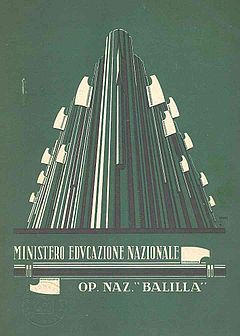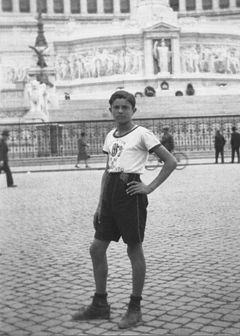- Opera Nazionale Balilla
-
Opera Nazionale Balilla (ONB) was an Italian Fascist youth organization functioning, as an addition to school education, between 1926 and 1937 (the year it was absorbed into the Gioventù Italiana del Littorio, GIL, a youth section of the National Fascist Party).
It was named after Balilla, the moniker of Giovan Battista Perasso, a Genoese boy who, according to local legend, started the revolt of 1746 against the Habsburg forces that occupied the city in the War of the Austrian Succession. Perasso was chosen as the inspiration for his supposed age and revolutionary activity, while his presence in the fight against Austria reflected the irredentist stance taken by early Fascism, and Italy's victories in World War I.
Contents
Origins
Nationalists in the years after the war thought of themselves as combating the both liberal and domineering institutions created by cabinets such as those of Giovanni Giolitti, including traditional schooling. Futurism, a revolutionary cultural movement which would serve as a catalyst for Fascism, argued for "a school for physical courage and patriotism", as expressed by Filippo Tommaso Marinetti in 1919. Marinetti expressed his disdain for "the by now prehistoric and troglodyte Ancient Greek and Latin courses", arguing for their replacement with exercise modelled on those of the Arditi soldiers ("[learning] to advance on hands and knees in front of razing machine gun fire; to wait open-eyed for a crossbeam to move sideways over their heads etc."). It was in those years that the first Fascist youth wings were formed (Avanguardia Giovanile Fascista in 1919, and Gioventù Universitaria Fascista, GUF, in 1922).
Creation
After the March on Rome that brought Benito Mussolini to power, the Fascists started considering ways to ideologize the Italian society, with an accent on schools. Mussolini assigned ex-Ardito and deputy-secretary for Education Renato Ricci the task of "reorganizing the youth from a moral and physical point of view". Ricci sought inspiration with Robert Baden-Powell, the founder of Scouting, meeting with him in England, as well as with Bauhaus artists in Germany.
The ONB was created through Mussolini's decree of April 3 1926, and was led by Ricci for the following eleven years. It included children between the ages of 8 and 18, grouped as the Balilla and the Avanguardisti.
Structure
- Balilla (boys) and Piccole Italiane (girls) - ages 8 to 14
- Avanguardisti and Giovani Italiane - 14 to 18
In time, a section named Figli della Lupa ("Children of the She-Wolf", alluding to the myth of Romulus and Remus; ages 6 to 8) was added. (note: Balilla and Avanguardisti were both substructures of the Opera Nazionale Balilla; the latter was not a separate organization.[1]
Between the ages of 18 and 22, young men and women would join additional groups of the ONB - Fasci Giovanili di Combattimento (see Fasci di Combattimento) and Giovani Fasciste, respectively. Male students in all forms of higher education were enrolled in the GUF.
While the National Balilla Institution was originally founded as an Ente Morale, in 1929 it was placed under the power of the Ministry of National Education, with the Head of the Government's related power devolving to the Minister of National Education.[2]
Character
The organization surpassed its purpose as a cultural institution that was intended to serve as the ideological counterpart of school, and served as a paramilitary group (training for future assignments in the Italian Army), as well as education in the career of choice, technology (including postschool courses for legal adults), or education related to home and family (solely for the girls). It carried out indoctrination with a message of Italian-ness and Fascism, training youths as "the fascists of tomorrow". During the years following its creation, ONB was left without real competition, as the regime banned all other youth movements - including Scouting - with the exception of the Roman Catholic Church group Gioventù Italiana Cattolica (which was forced to limit its activities).
Moreover, the ONB took charge of all activities initiated by schools, and pressured teachers to enlist all students. Aside from the usual "Fascist Saturdays", children would spend their summers in camps (which included the national-level Campi Dux, reunions of Balilla and Avanguardisti).
Male children enrolled wore a uniform adapted from that of the Blackshirts: the eponymous black shirt, the fez of Arditi tradition, grey-green trousers, black fasces emblems, and azure handkerchiefs (i.e.: in the national colour of Italy). During military exercises, they were armed with scaled-down version of Royal Italian Army service rifle, Moschetto Ballila[3] (the rifles were replaced with replica versions for the Figli della Lupa).
Mussolini's version of education
According to Mussolini: "Fascist education is moral, physical, social, and military: it aims to create a complete and harmoniously developed human, a fascist one according to our views". Mussolini structured this process taking in view the emotional side of childhood: "Childhood and adolescence alike (...) cannot be fed solely by concerts, theories, and abstract teaching. The truth we aim to teach them should appeal foremost to their fantasy, to their hearts, and only then to their minds".
The "educational value set through action and example" was to replace the established approaches. Fascism opposed its version of idealism to prevalent rationalism, and used the ONB to circumvent educational tradition by imposing the collective and hierarchy, as well as Mussolini's own personality cult.
See also
- Fascist Male Academy of Physical Education
References
Benito Mussolini, Fascism: Doctrine and Institutions, edition 1968. Howard Fertig, Inc. New York, 1968. pp. 264-77.
- ^ The "Balilla" organization for the physical and moral training of the young, article 5, law of 03 April 1926, No. 2247)
- ^ Abstracts from the Royal-Decree-Law of November 14, 1929, No. 1992
- ^ http://www.il91.it/balilla.html
Categories: 1926 establishments | 1937 disestablishments | Italian fascism | Youth organisations based in Italy
Wikimedia Foundation. 2010.


